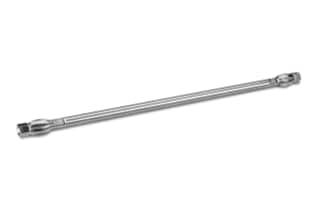
|
Chemistry |
C18 |
|
Separation Mode |
Reversed Phase |
|
Particle Substrate |
Hybrid |
|
pH Range Min |
2 pH |
|
pH Range Max |
11 pH |
|
Maximum Pressure |
6000 psi (415 Bar) |
|
Endcapped |
Yes |
|
Bonding Technology |
Shield RP18 |
|
Silanol Activity |
Low |
|
Particle Shape |
Spherical |
|
Particle Size |
5 µm |
|
Endfitting Type |
Waters |
|
Pore Size |
130 Å |
|
Format |
Column |
|
Surface Area |
185 |
|
System |
HPLC |
|
Particle Technology |
BEH |
|
USP Classification |
L1 |
|
Inner Diameter |
4.6 mm |
|
Length |
250 mm |
|
Carbon Load |
17 % |
|
UNSPSC |
41115709 |
|
Brand |
XBridge |
|
Product Type |
Columns |
|
Units per Package |
1 pk |

XBridge BEH Shield RP18 Column, 130Å, 5 µm, 4.6 mm X 250 mm, 1/pk
Optimize the test conditions that are imperative to achieving a successful separation using the XBridge BEH Shield RP18 Columns. Having the ability to successfully operate over a wide range of pH with a variety of solvents, the XBridge BEH Shield RP18 Columns offer an alternate selectivity.
Achieve superior separation of bases with the XBridge BEH Shield RP18 Columns. Reduced silanol interactions with basic analytes are observed with the XBridge BEH Shield RP18 Columns, which utilize the patented Shield Technology, and achieve highly symmetrical and efficient peaks. This deactivation of basic analytes is the ‘Shielding’ effect that results in improved peak shape. This is far superior than the ordinary C18 columns available in the market that give poor peak symmetry due to secondary interactions with basic compounds due to weak cation exchange with residual surface silanols.
Use less time and greater confidence in developing robust separations to fully utilize the power of pH with the XBridge BEH Shield RP18 Columns.
You may also be interested in other lab equipment such as the XBridge BEH Shield RP18 Column, 130Å, 3.5 µm, 1 mm X 50 mm, 1/pk similar to the product listed here but suitable for analytes with particle size 3.5 µm.
Shop for lab equipment and see the complete available range of Waters Xbridge BEH Shield Columns, and browse through other suitable lab equipment as well.
What Is The Difference Between C8 And C18 Columns In HPLC?
Both the C8 and C18 are two types of straight-chain alkyl groups used in the reverse-phase chromatography of HPLC for the surface modification of silica. The reverse-phase chromatography uses an aqueous, moderately polar mobile phase. The fundamental difference between C8 and C18 columns used in HPLC is that the stationary phase of the C8 columns contain octyl carbon chain (C8)-bonded silica, but the C18 column contains octadecyl carbon chain (C18)-bonded silica. In addition to this, the C8 columns are less hydrophobic, and have less density, while the C18 columns are more hydrophobic and have a higher density. For this reason, the C8 columns exhibit a low retention time, while the C18 columns have a higher retention time. And thus, lower separation is achieved with the C8 columns, but the C18 columns give a higher separation.